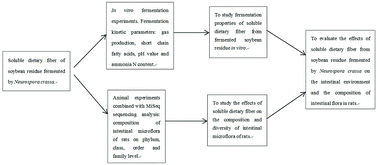Effects of soluble dietary fiber from soybean residue fermented by Neurospora crassa on the intestinal flora in rats
Abstract
In this study, soluble dietary fiber (SDF, including oligosaccharides and polysaccharides) of soybean residue (SR) fermented by Neurospora crassa was used as a research object. In vitro fermentation technology was used to analyze the fermentation properties of SDF from fermented soybean residue (FSR). Moreover, the effects of SDF from FSR on the composition and diversity of intestinal microflora of rats were studied by high-throughput sequencing technology. Results showed that the SDF content of fermented soybean residue was 27.21%. The addition of SDF in the range 2 to 10 g L−1 could increase the levels of gas production and short-chain fatty acids (SCFAs), as well as decrease the pH and ammonia N concentration after 24 h fermentation in the fermentation broth compared with the control group (p < 0.05). The animal-based experiments showed that Bacteroidetes and Firmicutes were the major dominant phyla in all the groups. Compared with the control group, oligosaccharides and polysaccharides of FSR changed the relative abundance and diversity of the bacterial community, and increased the numbers of beneficial flora, such as Prevotellaceae and Lactobacillales. It was shown that SDF of SR fermented by Neurospora crassa had great effects on the intestinal environment and the composition of intestinal flora in rats.



 Please wait while we load your content...
Please wait while we load your content...